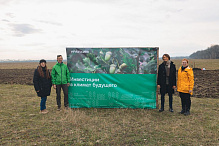Uralchem Launches an Afforestation Project
Today’s sustainability agenda pre-determines numerous challenges faced by companies across the world, and invites them to factor in new issues and revise existing strategies and business models. The Sustainable Development Goals were thus formulated to support long-term interests of the society and business.
Uralchem is in the process of systemic integration of the best ESG practices in its day-to-day and strategic activities. Climate change issues are a priority area for Uralchem, which became one of the first companies in Russia to launch a large-scale afforestation project to combat climate change. The project provides for a series of forest protection and restoration activities aiming to reduce emissions and increase absorption of greenhouse gases (GHG) including carbon dioxide. Climatic forest projects are among the most efficient approaches to decarbonisation, which is reduction of anthropogenic GHG emissions to limit climate change.

What makes Uralchem's project unique is the integrated approach to the renewable forest planting cycle, processing of felled wood and management of wood waste generated at all stages of the cycle. In the long-run, the project’s success will be determined by the degree of absorption of GHG, the preservation of bound carbon inside long-life construction materials made from planted wood, and long-term CO2 sequestration programmes as part of special waste management and recycling projects. If all stages of the project are implemented as a single chain of activities, carbon would be absorbed and stored for over 100 years. In implementing the project, Uralchem actively engages academic and industrial partners.
Stage 1 of Uralchem’s project began in November 2022 in in the Labinsky district of the Krasnodar Region (Russia). There, over 15,000 oak, hazel and ash seedlings were planted on three plots with a total area of 7 hectares. The planting of protective forests belts was conducted jointly with the Institute of Global Climate and Ecology and the Green Civilisation environmental resource centre.

The project seeks to determine carbon absorption and capture, to measure certain characteristics of different plant species in conditions of a moderately continental climate, and to then compare the results with the data accumulated to date by the IPCC (Intergovernmental Panel on Climate Change).
Mikhail Genkin, Uralchem Director of Strategy:
We expect the global climate community raise its interest in offset projects to capture CO2 from the atmosphere, and so we will continue our activities in this direction.
Another unique feature of Uralchem’s afforestation project is that it is of a so-called new type. Conventional afforestation projects do not account for the expiration of the planting stage within the overall life cycle of the planted trees. Instead, Uralchem offers a comprehensive approach, where – in addition to physical afforestation – wood is used in long-life structural elements and also waste management is applied. The approach also envisages a transition from disposal to sequestration: the bound carbon in wood waste will be collected and stored for a long time in anaerobic conditions at the bottom of the Black Sea subject to applicable environmental requirements. Experts believe this approach brings a number of benefits like construction of eco-friendly housing where carbon-intensive materials are partially replaced with wood planted for these purposes or special techniques of long-term sequestration of expired wooden structures etc.
Elena Eskina, Uralchem Chief Sustainability Officer:
Climate-related tasks require new non-conventional solutions. The implementation of climatic forest initiatives like this project aims to achieve common goals in reducing the human impact on climate change. In the future, this initiative will help absorb significant amounts of greenhouse gases and store bound carbon.
In collaboration with its partners, Uralchem is developing an integrated approach to process planted wood, calculate how much carbon is captured in finished wood products, and evaluate the use of wood as a substitute material in construction.

Oksana Lipka, Deputy Head of Unit for Studying Relations between the Atmosphere and Natural Terrestrial Systems of the Institute of Global Climate and Ecology:
Restoration of protective forest belts covers both aspects of climate action: mitigation through increased absorption of carbon dioxide from the atmosphere and also adaptation of agricultural activities. By introducing a continuous renewal of forest belts, using wood in long-life products, and capturing and preventing emissions from wood waste for decades, we made this project comprehensive and scalable.
Dmitry Fyodorov, Director of Green Civilisation:
In this joint work, we proposed mechanisms to design and test different combinations of tree species and plantation configurations. For this experiment in the Krasnodar Region, we marked the plots, prepared the soil, and then planted the seedlings. During the next several years we will be closely monitoring and supporting the growth of these protective plantations.
The success of a forest-based climate project will be measured its physical outcome. The difference between the amount of CO2 that the forest will absorb as it grows and the amount of CO2 generated if the forest is treated and managed properly can be expressed in tonnes of carbon dioxide equivalent, CDE. In turn, CDE tonnes can be monetised and converted into carbon units.
The efforts to reduce CO2 level with the use of forests have to be intensified continuously each year. Throughout the life cycle of a forest, growing conditions need to be improved, and investments have to be made in sanitary felling and pest control. These measures will increase absorption of carbon dioxide by forests as their photosynthesis capacity will be increased. This in turn will allow green financing mechanisms to be used.














